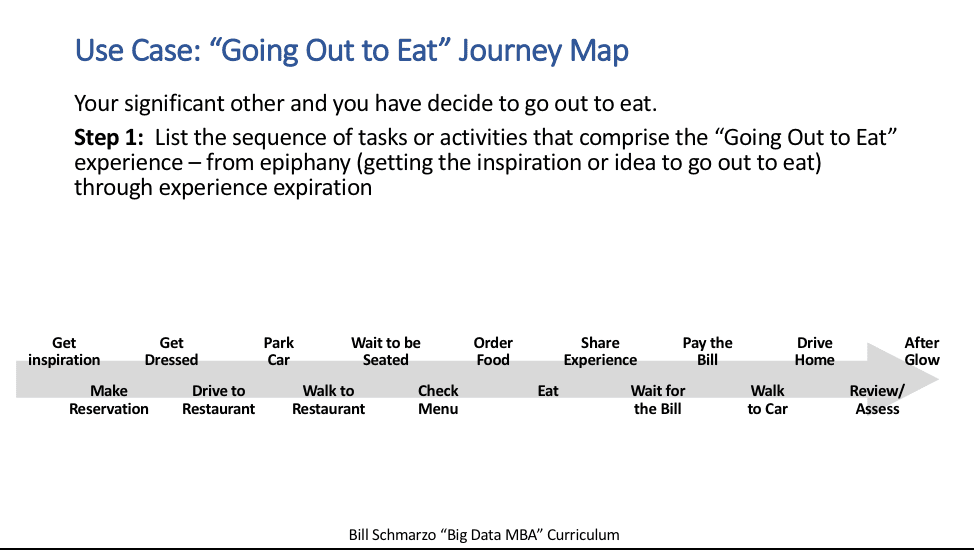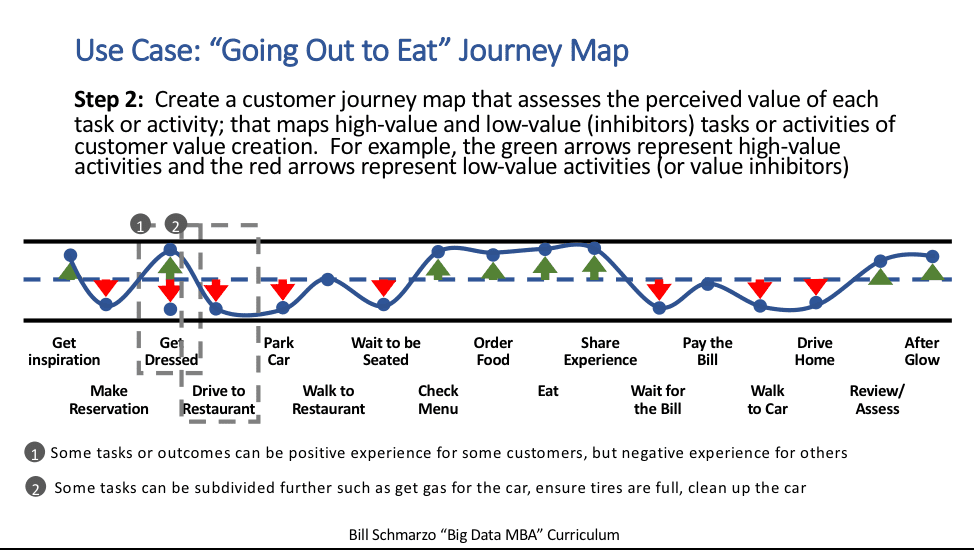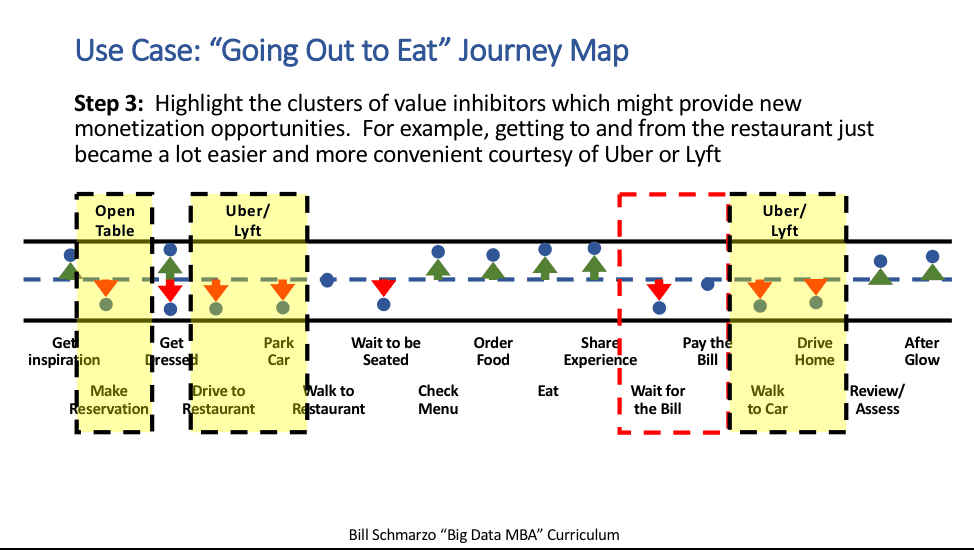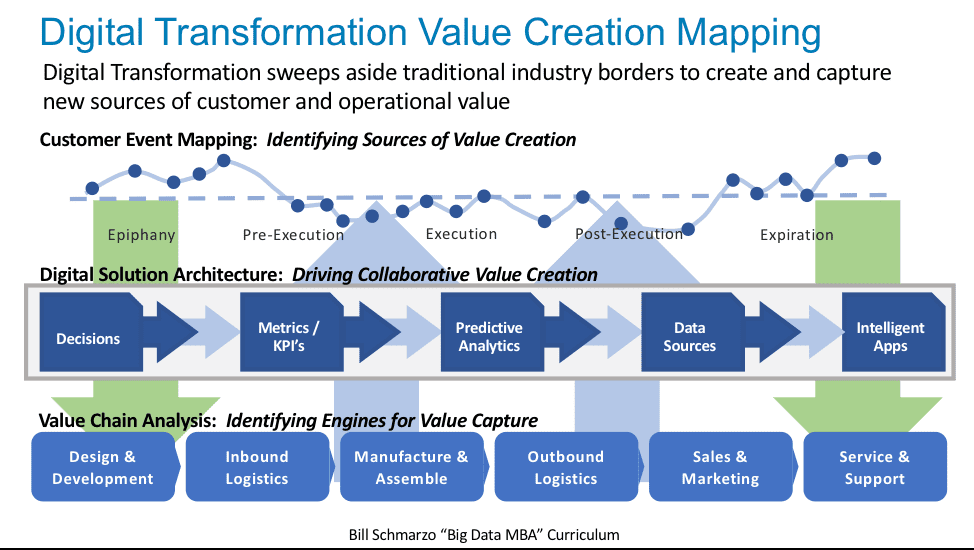Will I ever get this digital transformation thing right? The more work I do with clients on their digital transformation initiatives, the more I realize how much I don’t know. For example, first there was the “4 Laws of Digital Transformation”:
- Law #1: It’s About Business Models, Not Just the Business. Digital Transformation is about innovating business models, not just optimizing business processes.
- Law #2: It’s About Eliminating Barriers Associated with Time and Distance. Digital Transformation is about coupling digital technologies with digital assets in order to eliminate time and distance barriers in your business model.
- Law #3: It’s About Creating New Digital Assets. Digital Transformation is about creating new digital assets (data, analytics, and insights about customers, product, operations and markets).
- Law #4: It’s About Predictive Intelligence. Digital Transformation is about predicting what’s likely to happen, prescribing actions and learning from the results faster than your competition.
Then after a few customer engagements, we added a 5thLaw of Digital Transformation:
- Law #5: It’s About Creating More Compelling, Differentiated Customer Experience. Digital Transformation is about the creation of “intelligent” applications that not only deliver a more compelling user experience, but learn from each user engagement to become more relevant.
Now I’m going to add a 6thlaw (which is good, I guess, because that means we are continuing to learn):
- Law #6: It’s About Monetizing the Pain.Digital Transformation is about identifying, quantifying and eliminating the inhibitors to customer and market value creation.
Before we explore the 6thLaw of Digital Transformation, let’s begin with some background on digital transformation.
Why Digital Transformation?
Why the sudden interest (or concern, depending upon where you sit at table) with digital transformation? The acquisition of Whole Foods by Amazon provided a real-world wake-up call to many previously “untouchable” industries. As highlighted in the BusinessWeek article “Britain’s Robot Grocer Is Coming to the U.S.”:
“After the [Whole Foods acquisition by Amazon], supermarket executives worldwide looked across their aisles of veggies, dairy, and meat and saw the risk of becoming the next Barnes & Noble or Borders Group. “Amazon had previously made no impact in groceries, so grocers were able to sit back and think food is different,” Tim Steiner, chief executive officer of Ocado Group Plc says. “People have realized online is not going to be 1, 2, or 3 percent of their market. It’s going to be 10, 20, 30, or maybe even 60 percent.”
For organizations that have long insisted that their industry is immune to digital transformation, the harsh reality is hitting home. And the simple reason is that digital transformation is not confined to artificially-defined industry boundaries. In fact, if you think that your customer journey starts and ends at the four walls of your industry, then you’ve probably already lost.
To be successful, organizations must master a couple of key digital transformation tenets:
- Tenet #1: Identifying Sources of Customer and Market Value Creation. Organizations need tocombine customer journey mapping and digital economics to create an “outside-in” approach that identifies, validates, values and prioritizes the sources of customer and market value creation regardless of artificially-defined industry boundaries.
- Tenet #2: Optimizing Internal Engines of Value Capture. Organizations need to combine Michael Porter’s Value Chain Analysis, big data and data science to create an “inside-out” approach that identifies and prioritizes the internal digital capabilities necessary to capture these sources of customer and market value creation
The aha moment for me in constructing and understanding your customers’ journey maps (hint: you won’t have just one customer journey map because you don’t have just one type of customer) is identifying the digital transformation monetization points. While it’s obvious that the high-value, positive customer experiences (tasks, activities and outcomes) provide direct monetization opportunities, surprisingly it’s the pain points that also provide monetization and differentiation opportunities.
Thusly, Digital Transformation Law #6: It’s About Monetizing the Pain. This concept of “monetizing the pain” seems sort of strange, so let’s explore that law with an example to which everyone can relate – going out to eat.
“Going Out to Eat” Case Study
Let’s say that you and your significant other (or others) decide that you want to go out to eat. Just thinking about the opportunity to hit True Food restaurant or going to my favorite sushi, pizza, or burger joint gets me all fired up (yep, I like to eat).
Step 1 in the Customer Journey Mapping exercise is to list the sequence of tasks or activities that comprise the “Going Out to Eat” experience – from epiphany (getting the inspiration or idea to go out to eat) through experience expiration (see Figure 1).

Figure 1: List the “Going Out to Eat” Tasks or Activities
Remember that this customer journey map is from the perspective of the customer, not the restaurant. To be successful with digital transformation, we must think outside of the 4 walls that artificially define and confine our business model.
Step 2 then creates a customer journey map that assesses the perceived value (high, medium or low) of each task or activity in the journey. For example in Figure 2, the green arrows represent high-value activities and the red arrows represent low-value activities (or value inhibitors).

Figure 2: Relative weighting of high-value and low-value tasks
A couple of observations about Figure 2:
- Some tasks can be perceived as high-value by one persona, but low-value by others. For example, my wife loves deciding what she is going to wear (she’ll spend more time picking out her outfit than the time we actually spend going out). Me on the other hand, I hate that process (I think “Garanimals” were really developed for men like me). That’s why you need to create a different customer journey map, and supporting persona, for each customer type.
- Some tasks are ideal for further sub-dividing, which can yield more customer high points as well as pain points (and their associated monetization opportunities). For example, driving to the restaurant might necessitate a stop at the gas station, or paying a toll, or some other activity for completing that part of the journey.
In step 3 we want to highlight the low-value inhibitors which might provide monetization opportunities. For example, getting to and from the restaurant became a lot easier courtesy of Uber or Lyft (see Figure 3).

Figure 3: Examples of Monetizing the Pain Points
Uber and Lyft have successfully monetized the “Drive to Restaurant” and “Park Car” low-value inhibitors, as has Open Table successfully monetized the “Make Reservation” task. Hint: no one has monetized the “Wait for the Bill” and “Pay the Bill” low-value inhibitors.
The clear opportunity to monetize the pain points was really the “aha” moment for me. While there are certainly opportunities to monetize the high points of a journey (like providing tasty samples to promote the more profitable nightly specials), the real monetization opportunities come from mitigating or eliminating the pain points or the low-value inhibitors of the customer journey map.
Summary
Ultimately, …Digital (Business) Transformation is the infusion of digital capabilities into the organization’s processes, products, and assets to improve business and operational efficiency, enhance customer value, manage risk, and uncover new monetization opportunities regardless of artificially-defined industry boundaries.
Successful digital transformation requires us to marry our learnings from the customer journey map exercise with the organization’s value capture processes – think Michael Porter Value Chain Analysis meets Digital Economics meets Data Science meets Big Data (see Figure 4).

Figure 4: Digital Transformation Value Identification and Capture Mapping
Yep, the “Digital Transformation Value Creation Mapping” brings it all together to help organizations leverage data and analytics to digitally transform their business models.
To learn more about the “Going out to eat” example, check out my “Digital Transformation Introduction” video on YouTube, or any of the series of blogs that I have written on Digital Transformation.
- It’s Not Digital Transformation; It’s Digital “Business” Transformation! – Part I https://www.linkedin.com/pulse/its-digital-transformation-business-…
- It’s Not Digital Transformation; It’s Digital “Business” Transformation – Part II https://www.linkedin.com/pulse/its-digital-transformation-business-…
- It’s Not Digital Transformation; It’s Digital “Business” Transformation – Part III https://www.linkedin.com/pulse/its-digital-transformation-business-…
- The Customer Journey Digital Transformation Workbook https://www.linkedin.com/pulse/customer-journey-digital-transformat…
